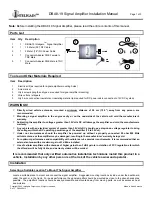
Philips Semiconductors
AN<nnnnn>
TDA1562Q application note
<12NC>
© Koninklijke Philips Electronics N.V. 2004. All rights reserved.
Application note
Rev. 01.02 — 05 May 2006
10 of 62
-When the voltage at pin 16 is between 2 and 3.3V, the device will only work in class AB
mode, class H operation will be disabled.
-When the voltage at pin 16 is higher than 4.2V, the device will be forced in class H
mode.
Warning: In this condition, the device will not switch from class H to class B mode
when the heatsink temperature reaches 120
°
C. Especially when the device is
driven so hard that the lifter capacitors are discharged completely, there is a risk
that the device will be damaged by excessive heat, so this is a mode of operation
which preferably should not be used for other purposes than testing.
When the Status I/O pin is used as an output pin, the voltage level at this pin will give
information about the operating mode of the device.
When the voltage is between 0 and 0.5V, the device is muted, when the voltage is
between 2 and 3 V, the device is in the class B operating mode. This will be the case
when the heatsink temperature is 120
°
C or higher. When the voltage is between (Vp-2.5)
and Vp, the device is in class H operation.
The Status I/O pins of several devices (maximum 8) can be tied together.
In such a setup, the device which has the lowest Status I/O voltages controls the Status
I/O voltage of all devices. For example, as long as one of the devices is muted, all other
devices will stay muted too. This way, all devices will switch from mute to operating at
exactly the same moment.
When the status I/O pin is not used, it should be left floating.
2.3 The diagnostic pin
The diagnostic pin (pin 8) is an open collector output pin which should be connected to
an external voltage through a pull-up resistor.
The maximum current the diagnostic pin can sink is 1.5mA.
The following conditions are indicated by the diagnostic output:
1. Clipping of the output stages:
When clipping occurs, the diagnostic output will remain low as long as the output
signal is clipping.
2. Short circuits to Gnd, Vp or across the load:
A short circuit to ground or to Vp will cause the diagnostic pin to go continuously
low.
A short circuit across the load will cause the diagnostic output to go low for
20ms, then high for 50
µ
s and then low for 20ms etc.. This will be repeated until
the short circuit is removed.
3. High temperature detection:
Just before the temperature protection becomes active, the diagnostic output will
go low continuously.
4. Load detection:
When the device is switched from stand-by to mute or on, a built in detection
circuit checks whether a load is connected to the outputs.
The result of this check can be seen at the diagnostic output when the device is
muted by means of the voltage at the mode select pin.
When the diagnostic output is high, a load has been detected. When it is low, no
load has been detected.











































